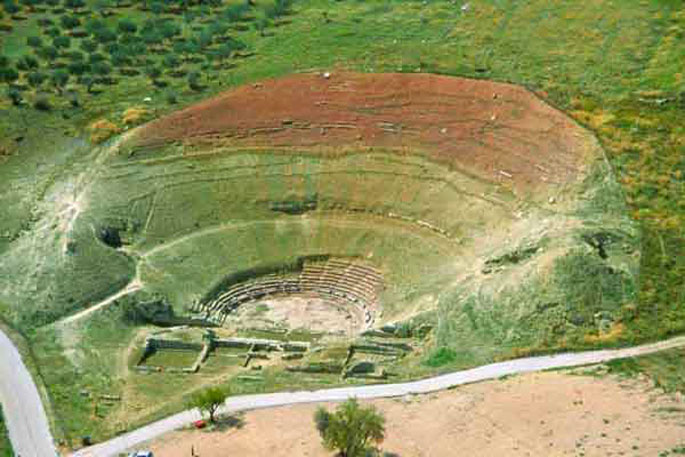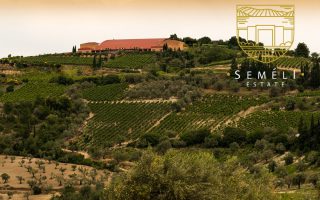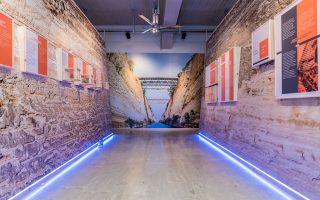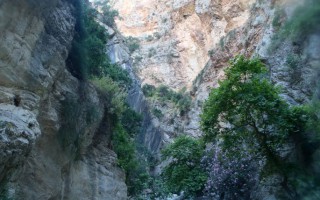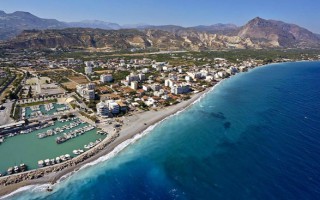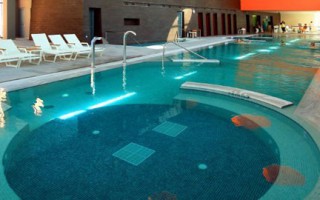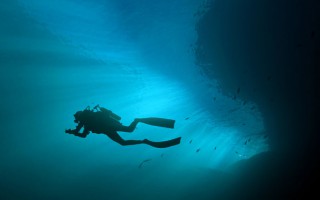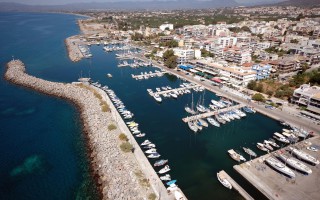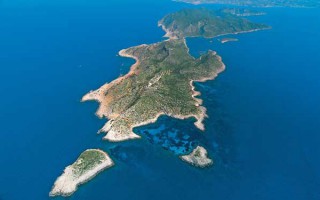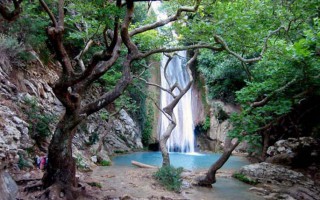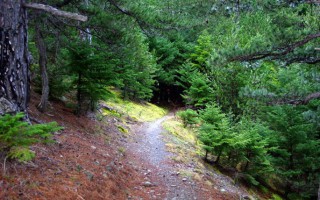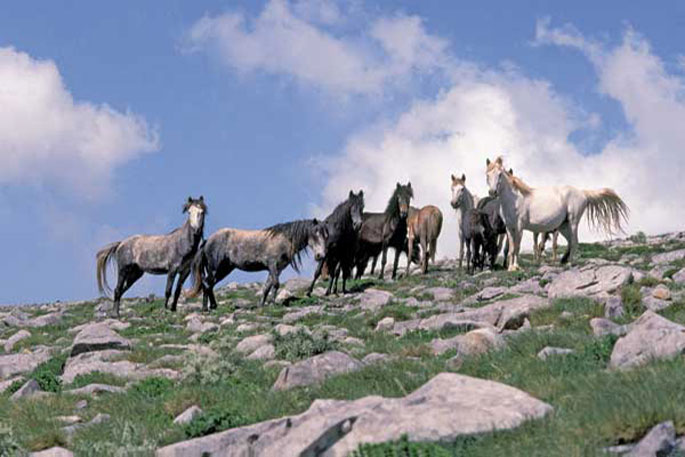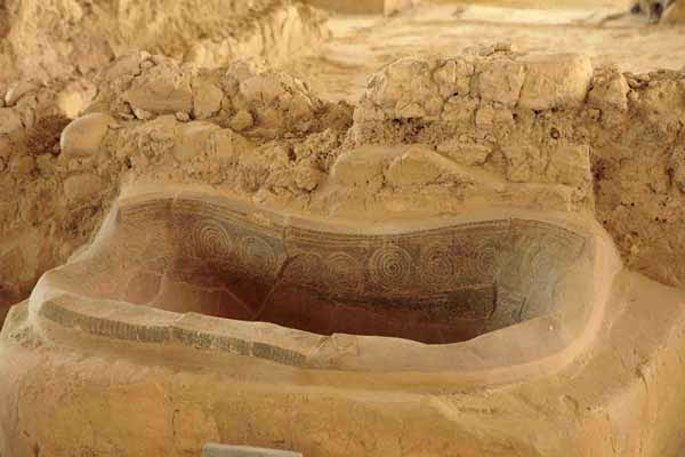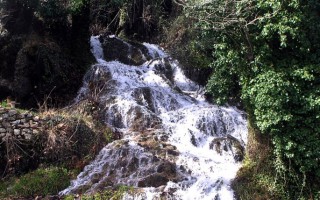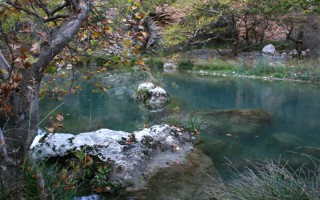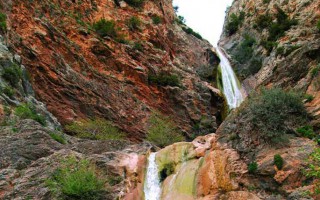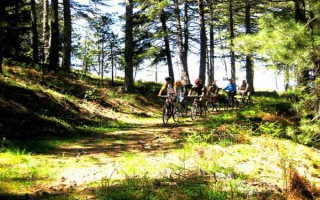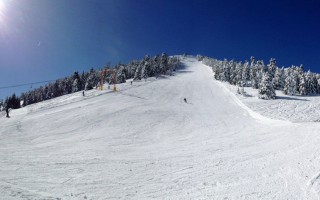Ancient Sicyon is located on the mound of Vasiliko, a village 4 kilometers to the southeast of Kiato, head of the municipality of Sikyona. In antiquity it was bordered with Corinth to the east, with the Achaean Pellini to the west, and the Arcadian Fliounta and Stymfalos to the south. It was built on a 2300 acres plateau. According to Strabo, Sicyon was located initially by the sea until Demetrios Poliorketes built a new town on the plateau. Demetrios conquered the city and persuaded the Sikyonians to move to the acropolis, leading them to a high triangular plateau. He named the city Demetrias. Most of the public buildings were constructed under the reign of Demetrios and later by Aratos who incorporated the city into the Achaean league. The ancient theater and the roman baths are the most imposing monuments of Ancient Sicyon.
The American School of Classic Studies conducted the first excavations in Ancient Sicyon at the site of the ancient theater, between 1886 and 1898. The excavations were centered around the area of the ancient agora and brought to light a temple, a palaestra, a Bouleuterion, a long Stoa, and a part of the theater’s cavea. All the visible monuments of ancient Sicyon were set according to the Hippodamus Urban Planning System, typical to the Hellenistic town, thus oriented to the four cardinal points.
The ancient theater was constructed during the first years of the foundation of the town, around 303 B.C., on the upper mountain plateau of the town. It consisted of the most adequate place to build a theater. Part of the seats was hewn to the rock. The excavations have brought to light the skene, the orchestra and part of the tiers of seats as well as the two vaulted passages leading to the upper diazoma. It is considered as one of the most spectacular theaters of this size, the diameter of its orchestra being 24 meters and the cavea 125 meters. The structure combines the technique of poros stone construction and the chiseling in the natural rock of the hillside. The prohedriai (seats of honor) were located at the first row. The two vaulted passages, leading to the cavea, consisted of the main entrances for the audience. They were 16 meters long and 2.60 meters high and they are preserved in good condition. The orchestra was made of packed earth, while a drainage channel covered by stone slabs runs vertically through the orchestra and ends in the rear of the Skene. The parodoi provided gated entrances similar to those in Epidaurus. The planning and the construction of the theater date back to the late 4th century or early 3rd B.C. The site was used for theatrical performances and political meetings by the citizens of Sicyon.
To the northwest of the theater lies the stadium. Its track is 207 meters long. Part of the retaining wall of sling can be visible though it has not been excavated yet. The stone roman baths, to the north of the agora, are preserved in good condition and they host, at the present, the Archaeological Museum. The visible parts of the ancient construction attest the existence of a large edifice structured around a central courtyard that dated to the 1st or 2nd century A.D.
The foundations of the Bouleuterion of Hellenistic Sicyon have also been discovered. It consisted of a spacious square edifice (40.5 × 41.15 meters) with four internal rows of four columns and a stoa along the façade, on the north side. Both the Bouleuterion and the stoa date to the Hellenistic Period and they were restored in later periods.
The Gymnasium was a large square building. The palaestra was built to the west of the agora, in two levels because of the nature of the ground. It consisted of the basic part of the Gymnasium. The lower lever, 72 × 36 meters, is the most ancient and it dates back to the early 3rd century B.C. The east part, considered the main Gymnasium, was constructed around 280 B.C. by the father of Aratus, Kleinias. The upper part was added later during the roman period.
Another monument worth visiting is the ruins of the archaic temple, near the Agora precinct, built in the 7th century. The temple was dedicated to Artemis or Apollo. It is an east oriented peripteral temple (38.07×11.55 meters) built of soft stone. The first construction phase dates back to the archaic period (6th century B.C.). The temple is of the only archaic edifice visible today. The ancient Agora extends to the east of the theater. It was the center of the excavations conducted by the Archaeological Society. The southwest side of the Agora was bordered by the large stoa, the Bouleuterion, the palaestra and a second stoa to the south of the palaestra The temple was located in the Agora.
Source: www.mythicalpeloponnese.gr
In 2012 took place the 18th Kalamata International Dance Festival, which is organized every summer by the International Dance Centre. The Festival is a permanent, recognised cultural institution, both in Greece and abroad, and it is one of the Prefecture of Messinia’s most important events.
The Festival has contributed to making Kalamata a point of a attraction for thousands of visitors each year, who have associated the name “Kalamata” with modern dance. Another important fact is that it helps promote Greek choreographers, by making their name known also outside of Greece.
Source: www.mythicalpeloponnese.gr
Every year, on the evening of Easter Sunday at 8.30pm on the western beach of Kalamata, at the old slaughterhouses, the locals revive the tradition of Saitopolemos. This peculiar local custom dates back centuries, during the Turkish occupation, when the Greeks displayed great heroism, as well as resourcefulness, during the battles against the Turks. According to the legend, the Messinians managed to stop the Turkish cavalry by constructing shuttles filled with explosives. The Turks outnumbered them, but the Greeks managed to defeat them with their trick.
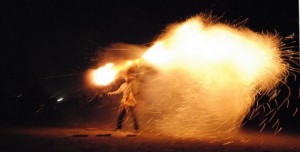 For the Shuttle War, the participants are divided into the so called “mpouloukia” (groups of people), after being properly prepared, by wearing their traditional costumes and armed with the shuttles they themselves constructed by cardboard tubes filled with gunpowder. This tradition is particularly popular among the locals and the visitors during the Holy Week, since it is indeed unique and triggers memories from the glorious struggles of the Greeks.
For the Shuttle War, the participants are divided into the so called “mpouloukia” (groups of people), after being properly prepared, by wearing their traditional costumes and armed with the shuttles they themselves constructed by cardboard tubes filled with gunpowder. This tradition is particularly popular among the locals and the visitors during the Holy Week, since it is indeed unique and triggers memories from the glorious struggles of the Greeks.
Source: www.mythicalpeloponnese.gr
The 13th Peloponnesian Equestrian Games – Show Jumping were successfully conducted in Kalamata in 2012. This is a major equestrian event organized for the 4th consecutive time by the Kalamata Equestrian Club. The games took place in the club’s facilities, which boast the necessary infrastructure to host such an important event.
Athletes from different levels and various equestrian clubs in the Peloponnese participated in the following categories: Junior, for riders between 5 and 6 years old; 0.60 cm obstacle height; 0.80 cm obstacle height; 1 m obstacle height; 1.05 m obstacle height and 1.10 m obstacle height. The equestrian games are well established as a tradition for the city of Kalamata, offering an exciting spectacle and simultaneously promoting the equestrian sport. Admission is free for all spectators.
Source: www.mythicalpeloponnese.gr
“The Routes of the Olive Tree” is a cultural, nonprofit, nongovernmental organization based in Kalamata. Its activities began in 1998, with the aim of promoting the culture of the olive through a series of activities and collaborations.
The starting point was ancient Pylos; not a random choice, given that the area abounds with testimonies regarding the presence of the olive in Greece since ancient times. The one responsible for this initiative was the President of the Chamber of Messinia George Karabatos, with the support of many others who share an affinity for the olive and for motorcycles. This initiative of theirs managed to bring the Mediterranean countries together into a single network, where the common denominator was the cultivation of the olive as well as an interest in its diffusion.Since then, the Routes of the Olive Tree have organized many events and have secured a plethora of international distinctions, such that of the “International Cultural Itinerary” by UNESCO in 2003 and the “Great European Cultural Itinerary” by the European Council in 2006.
Source: www.mythicalpeloponnese.gr
Ancient Messene is situated in the western foothills of mountain Ithomi, near the village called today Mavromati. A large part of the city has come to light, which reveals its great expanse and also its significance during ancient times. Ancient Messene was built in 369 B.C. by the general Epaminondas from Thebes after the battle at Lefktra, when he defeated the Spartans, invaded Laconia and released the Messenians from the Spartan rule.
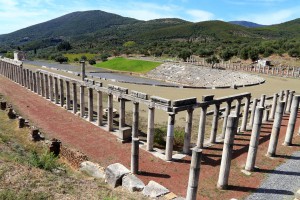 The traveller Pausanias visited the city between 155 and 160 B.C. and recorded significant information regarding its form and all public and holy buildings. First of all the stone wall that enclosed it, which was approximately nine kilometres long and protected the city from all directions, apart from the northeast, where Ithomi stood as a natural fort. Apart from part of this wall, the archaeological excavations also brought to light: the Theatre, which mainly hosted political assemblies, the Arsinoe Fountain, a large and impressive construction between the Theatre and the Agora, the western part of the Agora, the sanctuary of Zeus Soter, the sanctuary of Demeter and the Dioscouri, the Asclepium, which seemed to play an important role in the public life of the city, the sanctuary of a hero, probably Aristomenes, the Ecclesiasterion, the Stadium, the Gymnasium, as well as the Arcadian Gate, great in size, which is mentioned many times by the travellers as one of the archaeological site’s most impressive constructions.
The traveller Pausanias visited the city between 155 and 160 B.C. and recorded significant information regarding its form and all public and holy buildings. First of all the stone wall that enclosed it, which was approximately nine kilometres long and protected the city from all directions, apart from the northeast, where Ithomi stood as a natural fort. Apart from part of this wall, the archaeological excavations also brought to light: the Theatre, which mainly hosted political assemblies, the Arsinoe Fountain, a large and impressive construction between the Theatre and the Agora, the western part of the Agora, the sanctuary of Zeus Soter, the sanctuary of Demeter and the Dioscouri, the Asclepium, which seemed to play an important role in the public life of the city, the sanctuary of a hero, probably Aristomenes, the Ecclesiasterion, the Stadium, the Gymnasium, as well as the Arcadian Gate, great in size, which is mentioned many times by the travellers as one of the archaeological site’s most impressive constructions.
To the south west of Peloponnesus, next to the modern-day village of Mavromati, in ancient times lay the city of Messene, one of the most important ancient cities of the region, with a significant historical presence. The city was founded in 369 BC by the Theban general Epameinondas and his allies from Argos, with the purpose of excluding the Spartans from the Messenian region.
Video by fabdrone
Legend has it that the specific location for the establishment of the new city was selected after the location of the will of Aristomenes, a Messenian hero, was miraculously revealed through the intervention of priests and oracles. According to Pausanias, in order to populate the new city, Messenian immigrants in Italy, Sicily, Evesperides in Libya, as well as various other cities where they had settled, were called back. Most of them replied positively to the invitation to settle the new city, and together with the freed slaves and the perioeci (the free but non-citizens of Sparta), they comprised the first population of Messene. The city got its name from the legendary, pre-Doric queen of the land, who was the daughter of King Triopas of Argos and wife of Polycaon of Laconia. According to Pausanias, Messene was deified circa 10th century BC and was gradually declared one of the main deities of the city.
Systematic excavations started in 1895 by Themistocles Sofoulis and were continued in 1909 and 1925 by Georgios Oikonomou. Anastasios Orlandos later researched the area until 1974, while from 1986 the excavations are directed by Petros Themelis. Throughout these years, many public and sacred buildings were brought to light, as seen and described by Pausanias, who visited the city in years 155-160 AD, during the reign of Emperor Antoninus Pius.
 Ancient Messene was surrounded by a nine and a half kilometre wall, its largest part still standing to this day. It had two gates, the Arcadian Gate (or Gate of Megalopolis) and the Laconian Gate. This last gate was destroyed in the 18th century, but the Arcadian Gate is still preserved in fairly good condition, and in fact was the city’s landmark for the first travellers, who liked to depict it in their engravings. It is an enormous and imposing circular gate, with two entrances, one interior and one exterior.More discoveries were made in ancient Messene, such as the theatre, the agora, the temples of Demeter, the Dioskouroi, Zeus Sotiros, as well as of Isis and Serapis; the temple of a hero, the imposing Spring of Arsinoe, a large Doric temple, the Asclepeion, which was the most magnificent public building; the ecclesiasterion, which is a type of small theatre, the stadium, the gymnasium, and from later times a basilica of the early Byzantine era.
Ancient Messene was surrounded by a nine and a half kilometre wall, its largest part still standing to this day. It had two gates, the Arcadian Gate (or Gate of Megalopolis) and the Laconian Gate. This last gate was destroyed in the 18th century, but the Arcadian Gate is still preserved in fairly good condition, and in fact was the city’s landmark for the first travellers, who liked to depict it in their engravings. It is an enormous and imposing circular gate, with two entrances, one interior and one exterior.More discoveries were made in ancient Messene, such as the theatre, the agora, the temples of Demeter, the Dioskouroi, Zeus Sotiros, as well as of Isis and Serapis; the temple of a hero, the imposing Spring of Arsinoe, a large Doric temple, the Asclepeion, which was the most magnificent public building; the ecclesiasterion, which is a type of small theatre, the stadium, the gymnasium, and from later times a basilica of the early Byzantine era.
The city’s layout followed the hippodamian system, where all buildings have the same orientation and space is divided along horizontal and vertical axes. Hippodamus of Miletus was the father of this system. He was an architect, mathematician, urban planner and astronomer who lived circa 5th century BC, and he based his system on the three principles of democracy: isonomy (equality before the law), isopolity (equal civic rights) and isomoiria (equal share in land ownership).
The city fell victim to a raid by the Goths in 395 BC, led by Alarichus, and after that it gradually became deserted. It is however still one of the best preserved cities of the ancient world and one of the most interesting archaeological destinations.
Source: www.mythicalpeloponnese.gr
Fourteen kilometres from Pylos, on the hill of Epano Eglianos, in the previous century came to light the palace of Nestor, the famous king of Pylos. It is the best-preserved Mycenaean palace in the whole of Greece.
The palace complex comprises four structures, which include a series of apartments. Impressive is the fact that the interior was adorned by colour murals, and also the fact that the palace was never enclosed within a protective wall, since its location was enough to grant it ample protection. The palace seems to have been completely destroyed by a fire during the 12th century B.C., which, however, managed to preserve a plethora of clay tablets that contain significant information regarding the financial, social and religious life during Mycenaean times.Those who visit the area can also see the tholos tomb attributed to Nestor and his successor, Thrasymedes, which was discovered near the palace, as well as all the archaeological findings from the excavations, exhibited in the Museum of Chora.
The Mycenaean civilization flourished during the period between 1700—1001 BC in various parts of the Helladic region. Its archaeological traces were first discovered in the region of Mycenae, from where it takes its name. Amongst the most important findings this magnificent civilization has bequeathed to us are the tholos tombs and the grandiose palaces.
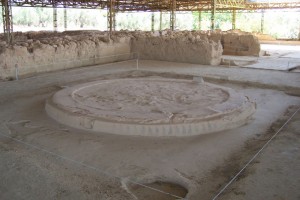 The palace of the mythical king of Pylos, Nestor, belongs to this category of Mycenaean palaces – in fact it is the best preserved of all those discovered in Greece. It is situated four kilometres south of the village of Chora, on the hill of Epano Englianos, and 14 kilometres from Pylos. The palace was built in the 13th century BC by King Nestor, son of Neleus, who is mentioned several times by Homer and holds an important role in his epic poems. Nestor led Pylos to the Trojan War with 90 ships and is described by Homer as a wise elder, his opinion always respected by the Achaeans.
The palace of the mythical king of Pylos, Nestor, belongs to this category of Mycenaean palaces – in fact it is the best preserved of all those discovered in Greece. It is situated four kilometres south of the village of Chora, on the hill of Epano Englianos, and 14 kilometres from Pylos. The palace was built in the 13th century BC by King Nestor, son of Neleus, who is mentioned several times by Homer and holds an important role in his epic poems. Nestor led Pylos to the Trojan War with 90 ships and is described by Homer as a wise elder, his opinion always respected by the Achaeans.
Heinrich Schliemann was the first to start looking for this mythical palace in 1888, having certain suspicions regarding its location, but he was not successful. It was not until 1939, after intensive excavations, when Konstantinos Kourouniotis, together with Carl Bergen, brought to light the first findings from the palace. World War II put a halt to excavations for some time, which were started again in 1952. Even though the largest part of the palace has been uncovered, research continues until the present day with the participation of the University of Cincinnati, USA.
This complex of palaces consists of four main buildings, which, in turn, have a large number of rooms – 105 according to calculations. The most important room is, of course, the so-called “throne room”, with its central round hearth. Additionally, the ruins of a central two-storey building and two auxiliary spaces were uncovered, while tholos tombs were excavated in the area surrounding the palace, one of them attributed to Nestor and his successor, Thrasymedes.
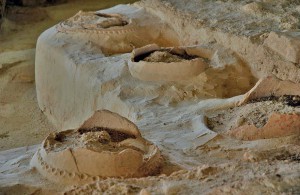 The numerous findings brought to light by the excavations include approximately 1,250 clay tablets written in Linear B. The tablets were deciphered in 1952 by Michael Ventris, an architect, and John Chadwick, a linguist. It is thanks to them that we are now in a position of knowing important information about the daily life, as well as the financial and commercial activities of prehistoric Pylos in general, and about the palace in particular. The remarkable thing about these tablets is the fact that they would not have been preserved to this day if not for a fire that levelled the palace in the 12th century. The palace itself never recovered from this disaster, but the fire had the effect of “baking” the clay tablets, making them more durable.
The numerous findings brought to light by the excavations include approximately 1,250 clay tablets written in Linear B. The tablets were deciphered in 1952 by Michael Ventris, an architect, and John Chadwick, a linguist. It is thanks to them that we are now in a position of knowing important information about the daily life, as well as the financial and commercial activities of prehistoric Pylos in general, and about the palace in particular. The remarkable thing about these tablets is the fact that they would not have been preserved to this day if not for a fire that levelled the palace in the 12th century. The palace itself never recovered from this disaster, but the fire had the effect of “baking” the clay tablets, making them more durable.
The numerous archaeological findings from the site of the Palace of Nestor are today kept at the Archaeological Museum of Chora.
Source: www.mythicalpeloponnese.gr
Every October the village of Kastanitsa, Arcadia, organizes the famous Chestnut Festival, which aims to bring out this product, with its great nutritional value and multiple commercial capabilities.The custom of celebrating the chestnut began in 1983 and has been taking place every year since then. The celebrations include, of course, the preparation and tasting of dishes based on the chestnut, and also traditional dancing, various exhibitions and informative talks regarding the chestnut, as well as a variety of topics of environmental nature. Those who are in the area in October must definitely make a stopover in Kastanitsa to experience the unique Chestnut Festival.
The Naturalist Association of the Natives of Kastanitsa, in collaboration with the Management Body of Mount Parnon and Moustos Wetland, organize the famous Chestnut Festival, with the aim to highlight the importance of this beloved crop in the agricultural and financial development of the wider area and also to promote this beautiful Tsakonian village, inviting more people to visit it.
The Chestnut Festival was organized for the first time in 1983 by the Kastanitsa Association and has been taking place every year since then. The visitors have the opportunity to taste traditional, mainly chestnut-based dishes and desserts – prepared both by professional chefs and the village’s women – accompanied by drinks and traditional music. There are also cooking and confectionery contests, again based on the chestnut, and also traditional dancing and various exhibitions, such as painting and photography.
The Festival is also a great opportunity for the visitors to get to know mount Parnon and its ecosystem better, through informative talks and excursions; they will also get to know the wider area of Tsakonia, with its special customs. It has been estimated that during the Chestnut Festival thousands of visitors flock to the area, providing a significant financial boost.
Source: www.mythicalpeloponnese.gr
If you happen to be in Leonidio for Easter, you will witness a truly amazing spectacle, which takes place on the night of the Resurrection. Hundreds of hot-air balloons, made of straw and paper, are set free into the sky when the congregation say “Christ is risen”, filling the night with lights and colours. The origins of this custom, which is not followed anywhere else in Greece, are unknown. Some argue that it is an Asian tradition, which seamen brought back home to Leonidio at the end of the 19th century.
The residents of Leonidio have one more reason to prepare for Easter a little earlier than usual. Every year, on the night of the Resurrection, they revive the tradition of the hot-air balloons, which are set free into the sky when the priest says “the Christ is risen”.
The balloons are made of straw and paper, and they include a special mechanism that allows them to be lifted into the sky. There is an opening on their lower part, inside of which they secure a piece of cloth dipped in oil and petroleum -the so-called “kolymmara”- which, once set on fire, heats the balloon and makes it take off. The balloons’ paper is light, and people use various colours of glue, in order to give the balloons a happy and vibrant effect. The balloons can be as large as two metres and they fly as high as 1,000 metres! When the fire goes out, they cool off and fall back down to earth.
So, few weeks before Easter, each family makes its own balloon, a ritual that every family member is involved in. There is also friendly competition over who will create the most impressive balloon. All five parishes of Leonidio participate in the custom, each one creating up to 100 balloons for that night! The sky is literally filled with these colourful and bright structures, creating a festive ambiance, which is of course accompanied with the fireworks and firecrackers. A few of the hot-air balloons are also freed in the sky in the afternoon, during the Liturgy of Love, from the main square in Leonidio.
The Night of the Balloons is a unique tradition, the origins of which are somewhat lost in the mists of time. This custom doesn’t exist anywhere else in Greece, which means that it’s well worth spending your Easter in Leonidio in order to experience this amazing view from up close.
Source: www.mythicalpeloponnese.gr
Every summer, the municipality of Gortynia organizes a series of cultural and athletic events. Within the framework of these summer events, they organize the annual Panhellenic Folk Song Contest in the village of Agia Paraskevi in Lagkadia, aiming to preserve and promote the local traditions, through their most important means of expression: folk music.
This tradition has taken place for 40 consecutive years and is open to amateur singers and musicians, who specialize in folk music, and especially in the old, rare and unreleased songs. Participants compete in the following three categories: 1) Best folk song interpretation by young people up to 18 years old, 2) Best folk song interpretation by adults and 3) Best performance with a traditional musical instrument.
The 39th contest in 2012 was dedicated to the late Domna Samiou, as a tribute to her contribution to Greek folk music.
Source: www.mythicalpeloponnese.gr

